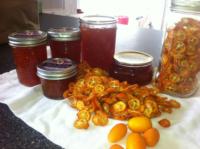Lemons
My Favorite Preserved Lemons
adapted from World Vegetarian by Madhur Jaffrey 
2 pounds organic lemons (preferably not meyer)
juice of 3 lemons
9 tablespoons sea salt
1/2 teaspoon seeds of brown cardamom (you can substitute green)
1 teaspoon black peppercorns
1 teaspoon cayenne (or paprika, or half of each)
16 whole cloves
1 & 1/2 tablespoons sugar (i use raw)
1 half gallon jar with screw cap, washed with hot soapy water & dried completely
1. Wipe lemons with a damp cloth or paper towels, then wipe dry. Leave to dry completely for an hour or so. To prevent mold there must be no water on lemons or inside of jar.
2. Grind peppercorns, brown cardamom seeds and cloves in a spice grinder or mortar and pestle. note: only the seeds of the cardamom should be used. To extract seeds from pods, crush pods with end of pestle, discard shells.
Stir the ground spices with salt, sugar and cayenne. i advise using the whole 1 teaspoon of cayenne even if you are not a heat lover as it is such a small amount, the lemons will not taste hot. But if you really do not like even the slightest bit of cayenne than go for the paprika. Set aside.
3. Thinly slice off the button end of each lemon. Slice each lemon into quarters. if you are working with very large lemons you may want to cut some of the quarters in half again. Remove seeds.
4. Place quartered lemons in a large bowl, add spice mixture and toss to coat. Fill 1/2 gallon jar with lemons, add the juice of 3 lemons and screw cap on.
5. Place on a sunny windowsill for 4-6 weeks. Shake once a day, or turn upside down, and right side up again once a day if you are confident the lid won't leak. For the first couple of weeks unscrew the top gently every two days or so to release fermentation gases.
Depending on how thick your lemon peels are, the preserved lemons will be ready to eat within 4 to 6 weeks. Begin to test at the 4 week mark, lemons are ready when peels are still slightly firm but soft enough to sink your teeth into. When you deem them soft enough, store in the fridge for up to a year or more.
To eat, scoop out a lemon quarter or two, rinse under cold water and discard the lemon flesh. chop to use in soups, stews, tangines, salads, and all manner of bean or rise dishes. Once you get a taste for these, there is nowhere you won't want to use them.
Melissa Clark suggests plucking the seeds out of a preserved lemon and then running it through a blender, in order to make an easy-to-use pulp. Instead of having a giant jar of inaccessible lemons, I could have a very accessible (smaller) jar of preserved lemon puree. This was an idea I could get behind.
The best thing about blending the lemons is that once you’ve scraped what you can out of the blender pitcher, you’re already halfway to a great salad dressing. Because it’s inevitable that you won’t be able to get every last bit out of the blender. Instead of surrendering and cleaning it out in the sink, add a little water, honey, and freshly ground pepper. Put the pitcher back on the blender base, run the motor on low and drizzle in a little olive oil. As soon as it develops a thick consistency, you’re done!
